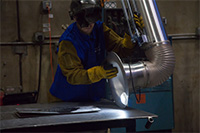Speak to an Air Purification Expert
Speak to an Air Purification Expert
Air Filtration Industry Articles, News And Resources
When To Use Media Filtration Instead of Electrostatic Precipitators
June 26th, 2024 | Posted in Air Cleaners

When mitigating CNC (or manual) machining coolant mist, the technology of choice is nearly always electrostatic precipitators. There are, however, exceptions. Let’s discuss some situations where media filtration is the preferred solution. But first, a quick review of these two technologies is in order. Electrostatic Precipitators or Electronic Air Cleaners Coolant mist removal starts with an impinger section. The larger spray and mist droplets impact the impinger and adhere to the plates or mesh. The…
Continue Reading »How Wildfires Affect Indoor Air Quality
June 24th, 2024 | Posted in General

The U.S. and Canada continue to experience devastating wildfires on a regular basis. The National Interagency Fire Center (NIFC) reports that, in 2023, a total of 56,580 fires burned 2,693,910 acres in the U.S. And at this time there are still large fires burning in Alaska, Florida, New Mexico and other states. All ready this year Canadian wildfires have been so large that they have impacted air quality as far south as South Dakota. Residents have experienced hazy skies as wildfire smoke fills the outdoor air. We know that this smoky outdoor air is dangerous to breathe, but do you know how wildfires affect indoor air quality? And what you can do to manage them?
Continue Reading »Positioning Of The Source Capture Hood During Welding
May 21st, 2024 | Posted in Welding

Updated 5/21/2024 For welding, AQE recommends utilizing a source capture hood as the primary means of capturing smoke, fumes and VOC’s. For many manual welding jobs, the welder will be welding on parts that are positioned or clamped on a table or bench. In addition, there may be a custom fixture in use to assure repeatability. For larger weldments, the welder will be welding directly on a part that is “free-standing”. In either scenario, the…
Continue Reading »Economic And Environmental Advantages Of Electronic Filtration For Coolant Mist
February 14th, 2024 | Posted in Air Cleaners

When specifying a machine tool coolant mist filtration system, the purchaser is confronted with the choice between an electronic filtration unit or a media filtration unit. Given that electronic units are generally a few hundred dollars more expensive the question often becomes, what does the buyer get for the extra money? The short answer is: Long-Term Savings. In order to justify that statement, a short description of the two coolant mist filtration technologies is in…
Continue Reading »Potassium Permanganate In Air Filtration Systems
December 21st, 2023 | Posted in Air Cleaners

In an earlier blog we discussed the properties of granular activated carbon (GAC) as a widely used sorbent medium for removing gas phase contaminants from air to be recirculated in the workplace air. GAC works by physical adsorption and is generally effective in removing many gas phase contaminants. There are, however, a number of gas phase contaminants that are not effectively removed by GAC. In these instances, a sorbent bed that acts via chemical adsorption (or…
Continue Reading »Overview Of Activated Carbon
November 29th, 2023 | Posted in Air Cleaners

What Is Activated Carbon? This is an extremely porous material. It has been described as a microporous inert carbon matrix. Activated carbon is generated in a two-step process. First a material high in carbon such as wood, coal, peat, or in case or activated carbon for removal of airborne odor and hydrocarbon contaminants, coconut shells. This material is heated to 600 to 900 degrees Celsius in an oxygen-deficient atmosphere creating a carbon “char”. In the…
Continue Reading »Mist Collector Benefits Beyond Employee Health And Safety
June 19th, 2023 | Posted in Air Cleaners

When working to very close tolerances, variations of 10 or 20 in shop temperature can make a difference in critical part dimensions. For example, the thermal expansion coefficient of stainless steel (which varies somewhat depending on the alloy) is approximately 5.2 to 9.6 millionths of an inch/inch diameter per degree Fahrenheit[i]. Therefore a 20 degrees F difference can make a dimensional difference of 118 to 192 millionths, or about 1 or 2 tenths of a thousandth…
Continue Reading »Is HEPA Filtration Really A Big Deal?
March 2nd, 2023 | Posted in Air Cleaners

We read a lot about HEPA filtration when dealing with indoor air quality concerns. That leads one to ask: “What’s so special about HEPA?” High Efficiency Particulate Air (HEPA) filters (also known as H13 or H14 filters in many countries) are media-type filters with an extraordinarily high filtration efficiency. By definition, new HEPA filters can remove airborne particles of 0.3 microns in diameter with 99.97% efficiency. The 0.3 micron criterion is selected because that particle…
Continue Reading »Pollution Control Units (PCUs) for Restaurant Kitchen Exhaust
February 6th, 2023 | Posted in Air Cleaners

Many people enjoy the smell of a grilled steak or hamburger, or Chinese food sizzling in the wok. For those living next door to a restaurant, however, these cooking aromas can quickly become cooking “odors” and are often considered to be tiresome and may result in odor complaints. These complaints may lead to the landlord of a leased restaurant space requiring the restaurant to install a kitchen exhaust Pollution Control Unit (PCU) to address these objections. It…
Continue Reading »Mist Collection Technologies
January 11th, 2023 | Posted in Air Cleaners

There are three common types of mist collectors: Electrostatic Precipitators Media Filtration Centrifugal Collectors Let’s look at how they work and their relative strengths and weaknesses. Electrostatic Precipitators or Electronic Air Cleaners Coolant mist removal starts with an impinger section. This typically consists of either a series of chevron-shaped plates or a coarse metal mesh. The larger spray and mist droplets impact the impinger and adhere to the plates or mesh. The accumulated coolant flows by…
Continue Reading »
